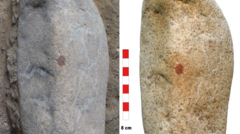Recent findings from a site in Segovia, Spain, indicate that a Neanderthal may have created one of the oldest examples of portable art, revealing their capacity for symbolic thinking.
Neanderthal Artistry: Ancient Fingerprint Reveals Creative Potential

Neanderthal Artistry: Ancient Fingerprint Reveals Creative Potential
A groundbreaking discovery in Spain suggests Neanderthals may have been capable of creating art, as scientists uncover an ancient fingerprint on a painted pebble.
Scientists in Spain have unveiled a remarkable archaeological find that challenges our understanding of Neanderthal capabilities. A rock resembling a human face was unearthed from the San Lázaro rock shelter, bearing what is believed to be the oldest full human fingerprint—potentially left by a Neanderthal male who dipped his finger in red pigment approximately 43,000 years ago.
The discovery, announced by a research team led by Prof. María de Andrés-Herrero of the University of Complutense, points towards the possibility that Neanderthals engaged in artistic endeavors. The stone, found beneath sediment layers associated with Neanderthal habitation, bears a strategically placed red dot that the researchers interpret as evidence of "symbolic behavior."
In an interview, Prof. de Andrés-Herrero recounted the team's surprise upon finding the larger stone, which stood out from the other artifacts at the site. Initial skepticism regarding the nature of the dot subsided once analysis confirmed it as a pigment. Collaborating with Spain's scientific police, they conducted multi-spectrum analysis that revealed a male adult fingerprint associated with the mark.
Although identification of the fingerprint is challenging due to the lack of comparative Neanderthal references, the discovery marked a significant addition to the dialogue surrounding Neanderthal artistic expression. Archaeologist David Álvarez Alonso emphasized the uniqueness of the artifact, labeling it the oldest known painted portable object within Europe, and a rare example of Neanderthal artistry.
Professor de Andrés-Herrero stated that the pebble's non-utilitarian nature indicated it was likely created for artistic purposes, not merely as a tool. The researchers contend that one of the Neanderthals intentionally marked the stone with red ochre, a pigment that does not naturally occur at the site.
In their published findings within the journal Archaeological and Anthropological Sciences, the team describes the exceptional characteristics of the pebble, which they propose reflects the cognitive sophistication of Neanderthals and positions it as a significant piece of potential portable art.





















